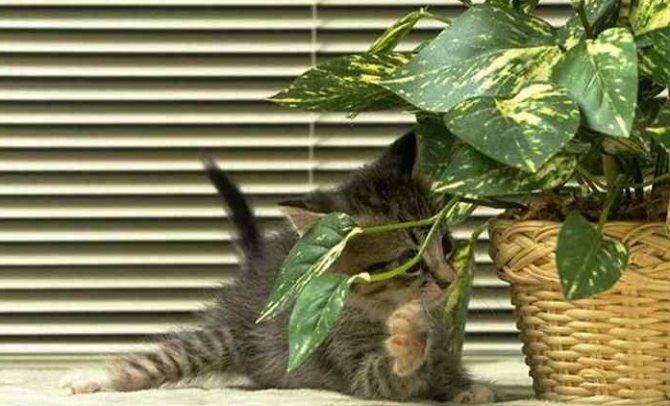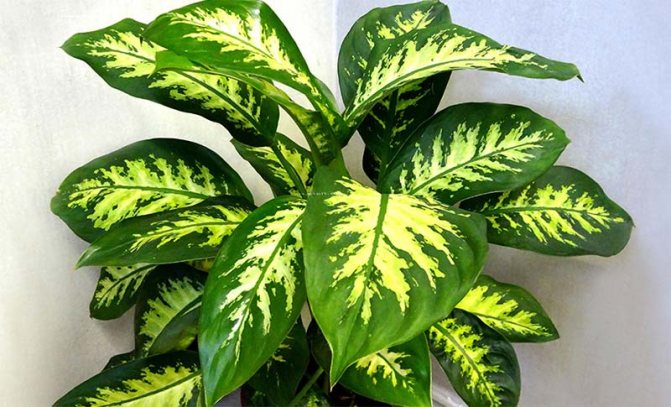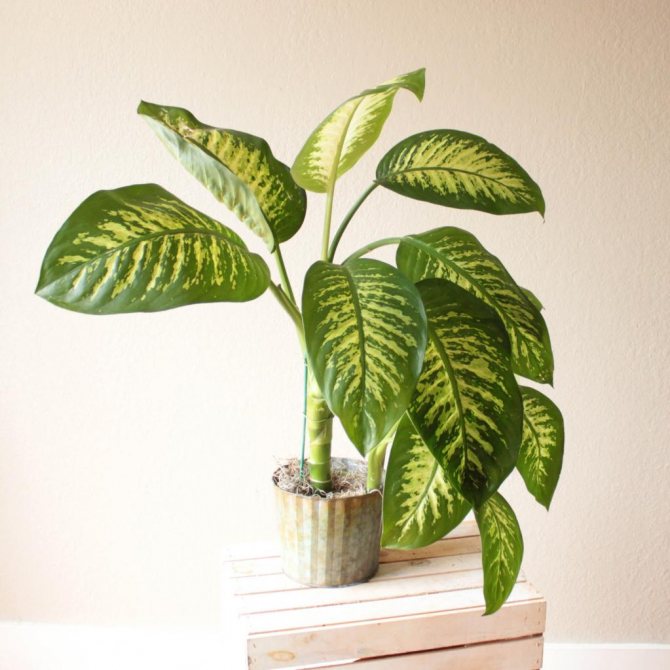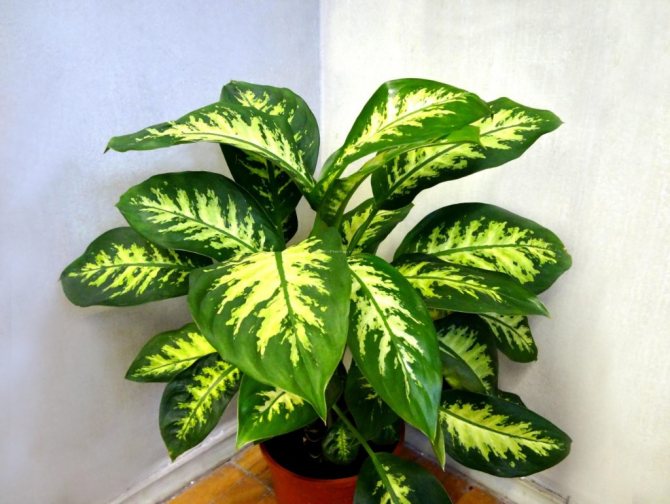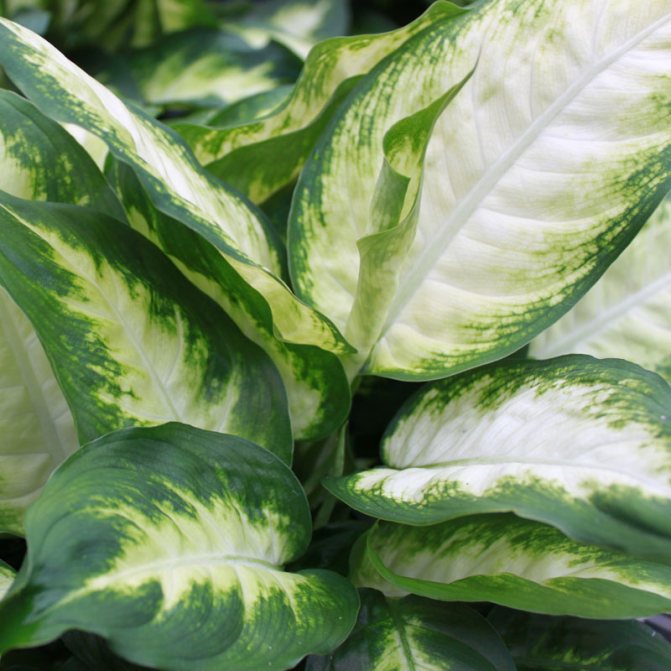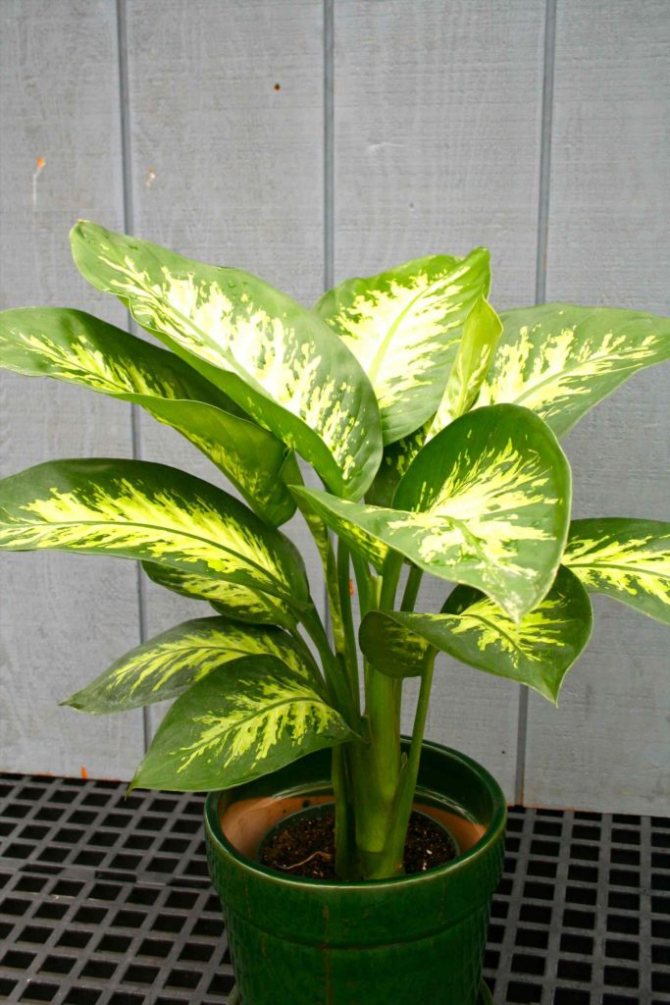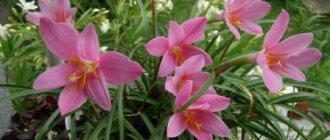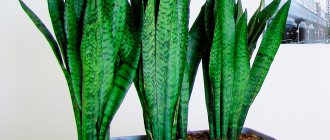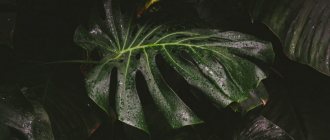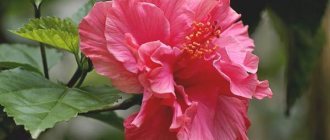
The appearance of dieffenbachia in the house is always accompanied by a lot of not very pleasant omens. What is not said about a poor plant: it takes the male power and even survives from the house of the stronger sex, and you cannot put it in the bedroom, because then you will not see heirs (apparently for the reason that a man and dieffenbachia are not compatible). It is rather difficult to say where so many prejudices come from. Therefore, let's figure out all the nuances together and find out - is dieffenbachia really harmful and how poisonous it is.
Why a flower is dangerous for people
Dieffenbachia Milky Juice contains toxic substances: after contact with liquid, dermatitis, burns and allergies appear on the skin. The juice that gets into the eyes causes tissue swelling, as a result of which a person develops conjunctivitis, temporary blindness.


The pet is so dangerous that it can cause serious harm to humans.
How does flower allergy manifest?
An allergic reaction to a bush looks exactly the same as a reaction to dust, wool, citrus fruits. A person begins to have a dry cough and / or a runny nose that does not go away for a long time, itching, watery eyes.
Usually allergies delivers only minor inconveniences... In rare cases, the disease can become the basis for the development of bronchial asthma.
Burn symptoms
When the juice gets on the skin, its swelling, redness, and blisters appear on it. This process is accompanied by burning pain and severe itching.
Dieffenbachia juice in the eyes is accompanied by the following symptoms:
- Pain in the eyes;
- photophobia;
- lacrimation;
- blepharospasm;
- changes in intraocular pressure;
- deterioration of vision, up to its complete loss.
A dangerous condition also develops when the juice of a poisonous plant enters the mouth. Within a few seconds, the victim feels an unbearable burning pain in his mouth. Other symptoms of a burn of the oral mucosa with dieffenbachia:
- increased salivation (hypersalivation);
- swelling of the mucous membrane of the mouth, larynx, salivary glands and tongue;
- violation of the swallowing process;
- temporary loss of speech function.
A severe burn with dieffenbachia juice can lead to such a pronounced edema of the mucous membrane of the oropharynx that the patient develops obstruction of the upper respiratory tract, accompanied by respiratory failure.
In case of toxic dermatitis that develops after skin contact with dieffenbachia juice, first aid consists in rinsing the damaged area abundantly with cool running water. To reduce pain, the surface can be sprayed with Lidocaine spray.
In case of a chemical burn of the eyes caused by dieffenbachia juice, they should be rinsed for a long time, at least 15-20 minutes, with cool water. Then, in order to prevent secondary infection, a solution of Sulfacil sodium, Furacilin or Levomycetin eye drops should be instilled into the eyes.
If you burn your mouth, rinse your mouth with plenty of water. There is no point in washing the stomach, since burning pain occurs in the oral cavity almost instantly and the victim does not have time to swallow the poisonous leaf, spits it out. To reduce pain, you can rinse your mouth with a 0.5% solution of Novocaine or Procaine. After that, the patient is given milk and cool water to drink.
Is dieffenbachia poisonous: can or not keep at home
There is an opinion that appearance is often deceiving - this statement completely coincides with the description of dieffenbachia. Under the beautiful appearance, there is a poisonous juice that provokes the occurrence of edema and burns, and is also a trigger for the development of a severe allergic reaction.
After contact of the liquid contained inside with the mucous membrane of any living organism (eyes, nose, mouth), the place of contact burns and swells. These phenomena are so strong that a person temporarily becomes blind and dumb.


It is not surprising that a person can go to the hospital after contact with the juice of this plant.
An exception to this rule is people with individual intolerance: the patient begins an allergy, which in some cases provokes the development of heart failure.
During any manipulations, it is recommended to use rubber gloves. At the end of the work, the limbs must be thoroughly washed with soap.
On children and petswho are most susceptible to poisoning, because they are curious about any interesting object, poison has a stronger effect.
In the house where they live, it is better to abandon the cultivation of a tropical pet. As a last resort, dieffenbachia can be kept out of reach.
Is it harmful only during flowering
The shrub rarely enters the flowering phase. Flowers of a poisonous tropical plant are not particularly beautiful.
Biologists are confident that flowers are quite safe for a person. Regardless, they recommend that gardeners cut off the arrow on which the flowers form. Flowering negatively affects the condition and appearance of dieffenbachia - the plant weakens greatly, and in some cases even sheds its leaves.
The level of toxicity does not depend on whether the plant is blooming or not, since the milky juice contains substances harmful to humans all year round.
Precautions
In order for dieffenbachia to bring only joy, special care must be taken when caring for a flower and when transplanting it:
- When pruning a plant or breaking off spoiled leaves, you need to wear rubber gloves.
- You can only transplant a flower with gloves.
- You should not put a pot with a plant in the nursery, especially if the children are small and like to try everything on the tooth.
- The flower should be out of reach for pets;
- After caring for the flower, wash your hands thoroughly with soap.
- In case of accidental contact with plant juice, the mucous membrane is washed with running water.
- If the juice gets on the skin, it is also thoroughly washed and antihistamines are taken.
- If part of dieffenbachia has been swallowed, it is necessary to rinse the victim's stomach, give sorbents and antiallergic agents.
If, if you accidentally eat a part of a houseplant, symptoms of laryngeal edema appear, you must urgently call a doctor!
Dieffenbachia is considered one of the most unpretentious indoor flowers.
Dieffenbachia juice is poisonous due to the alkaloids it contains. However, few adults will chew on parts of the plant, so the risk of poisoning is minimal. Such a plant must be kept away from small children and pets, and then it will do nothing but benefit.
Among indoor flowers, dieffenbachia is almost in first place in terms of the number of rumors and bad omens associated with it. Plants are feared not only because they are poisonous, but also for many other reasons.
It is believed that it negatively affects a person. The danger of dieffenbachia, according to many people, lies in the childlessness that it imposes on married couples. According to signs for unmarried girls, life next to dieffenbachia can turn into celibacy.According to another version, a flower placed in rooms with a bad atmosphere absorbs all negative energy.
Existing signs and superstitions regarding dieffenbachia
Among the ornamental varieties grown at home, dieffenbachia is located in the first five in terms of number will take... The meaning of the largest number of these superstitions is that unmarried girls and women should not use a flower as the color of their home.
Dieffenbachia belongs to a group of indoor flowers called muzhegons. It is believed that they are able to weaken the energy of men, thus, driving them out of the house.
No matter how hard the owner of the flower, unencumbered by marriage, tries to build strong relationships, they end in a complete fiasco, gradually developing into a fleeting affair.
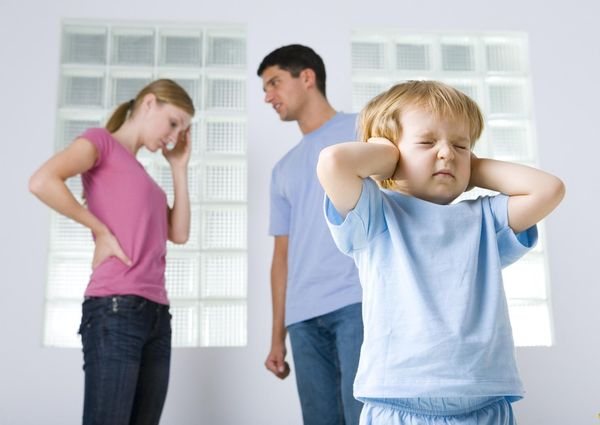

Mainly, the signs relate to family problems.
Dieffenbachia not only hinders the creation of a family, but also destroys long-established strong alliances: misunderstandings and disagreements arise between the spouses. Such a negative emotional situation after a while ends with a break in relations.
According to ancestors, people who have dieffenbachia in their home become sterile. It is believed that a married couple can have a child only after the notorious plant disappears in the house.
According to the reviews of the numerical owners of a tropical plant, most of these signs are not implemented in practice.
The flower of loneliness and hopelessness
For many years
knowledgeable people warn against keeping dieffenbachia in the house where girls live "for marriage": supposedly the flower has bad energy that can scare away grooms. But this is far from all that is blamed on this, at first glance, absolutely ordinary house plant.
They say
that in the house where dieffenbachia grows, there are rarely guests. Feeling the negative energy of the plant, they feel uncomfortable, try to leave quickly and never return. But the most amazing thing is that the stronger sex also contributed to the formation of the image of a villainous flower. Men complain that dieffenbachia, no less, deprives them of ... masculine strength.
And from here appeared and Another
accusing a plant is practically a sentence. Allegedly, in a family growing Dieffenbachia, there will not only be peace and tranquility, but also heirs. And even if you put it in the farthest corner of the apartment, far from the matrimonial bed, then from there the plant will send its ominous biocurrents and will not allow conception to occur.
The severity of the accusations that fell on the green "head" of the poor Dieffenbachia would be incomplete if we did not mention one more sign, according to which it destroys families and provokes men to go "left". This phenomenon
calls "muzhegonstvo" - dieffenbachia expels men from the house, leaving women abandoned and unhappy. That is, even women who are happily married run the risk of becoming lonely overnight, having settled this witch plant in their home.
Benefits of Difinbachia
Biologists know that a flower is an air purifier in the house from microscopic and chemical particles.


The variety can be called a natural humidifier due to its properties.
There are other benefits from it:
- The leaves of the plant are capable of absorb formaldehyde, which is used for the manufacture of varnishes for the treatment of various surfaces. This harmful substance is also used in the manufacture of furniture.
- The plant can absorb the chemical components of cleaning and detergents - benzene, ammonia, chloroform.
- With the help of reproducible phytoncides, it kills pathogenic bacteria.
- In the winter season, when the air in the house is dry by heating devices, dieffenbachia perfectly copes with the role of a humidifier: An impressive amount of moisture evaporates from the surface of large sheet plates.
- It is worth getting a bush for people who are allergic to dust. The thing is that the flower is able to reduce the number of microscopic particles in the air.
When is medical attention required?
Toxic dermatitis with dieffenbachia burns usually goes away quickly and patients usually do not seek medical help. If symptoms persist within a day, the lesion should be lubricated with zinc mash or corticosteroid ointment, such as Prednisolone.
In case of a chemical burn of the eyes, after providing first aid, the victim should be immediately taken to the emergency room of the nearest ophthalmological hospital. Treatment in this case is carried out using eye drops containing antibiotics, anti-inflammatory drugs and local anesthetics. With severe pain syndrome, pain relievers are prescribed.
If dieffenbachia juice gets into the oral cavity, seek medical help as soon as possible, as the patient may develop airway obstruction, leading to suffocation. To reduce pain, nonsteroidal anti-inflammatory drugs are prescribed in the form of injections. The detoxification therapy is shown. To stop the edema of the mucous membrane of the oropharynx, patients are prescribed diuretics (Furosemide, Lasix), Euphyllin, corticosteroids (Prednisolone, Dexamethasone). In case of ineffectiveness of the drug treatment and an increase in respiratory failure, tracheal intubation is performed, and the patient is transferred to an auxiliary artificial ventilation of the lungs.
Description of the flower
Dieffenbachia (mistakenly called Difinbachia, Difinbachia) forms large leaf plates of variegated color. In nature, plant height often reaches 2 m, but it is almost impossible to grow a shrub to such an impressive size at home.
During active growth, the shrub throws off the lower leaves, and then forms new ones at the top. Due to this feature, the flower becomes like a palm tree.
Amateur gardeners who decide to bring dieffenbachia to their home need to know about some of the secrets of this beautiful plant. We have described various aspects of care in the article on proper care for dieffenbachia at home.
Before buying a plant, you must find a place for him on a hill, which will be a kind of barrier for the little residents of the house.
Dieffenbachia is an ornamental houseplant that can be found quite often in residential buildings or in office premises, since it is an excellent decorative element for any interior. However, few people know that this flower is by no means harmless. Many amateur flower growers say that dieffenbachia brings bad energy to the house, and is also a rather poisonous indoor plant. Let's try to figure out whether dieffenbachia is really harmful and what effect it can have on a person?
Dieffenbachia - benefits and harms
Dieffenbachia is a fairly beautiful flower, which, moreover, is capable of bringing tangible benefits. It is known that this plant contains phytoncides that improve the chemical composition of the air and cleanse it of harmful microorganisms. In addition, dieffenbachia absorbs toxic substances such as formaldehyde, xylene, trichlorothylene and benzene. That is why ecologists often recommend growing these plants in industries where a huge amount of toxins are released during the working process. On top of that, dieffenbachia helps humidify the air, which has a beneficial effect on reducing the amount of dust in the room. There is also an opinion that this representative of the flora has a positive effect on the human cardiovascular system.
Despite all the many useful properties, dieffenbachia can cause serious harm to the human body. The thing is that the leaves and stems of the plant secrete a very poisonous juice. As a result of contact with the skin, mucous membrane of the eyes or mouth, severe edema and irritation may occur. Thus, the poisonous substance contained in the plant can provoke blindness, swelling of the tongue and even dumbness for a while.
Dieffenbachia - folk signs
The houseplant dieffenbachia is popularly known as muzhegon. In addition to the fact that this plant “drives the stronger sex out of the house,” it is believed that dieffenbachia has a negative effect on the potency of men. So, according to folk signs, in a house where dieffenbachia grows, married couples will not be able to have offspring for a long time.
Can Dieffenbachia be kept at home?
Of course, there is no doubt that dieffenbachia is poisonous. However, if you handle it correctly and follow certain precautions, the plant will not be able to cause tangible harm to the health of an adult. Therefore, it is recommended to use gloves when caring for dieffenbachia, after each procedure, wash your hands thoroughly with soap and water, and also do not allow the juice of the plant to get on the mucous membranes and skin.
Of course, if there is a small child in the house, there is a chance that he will want to taste the flower. Moreover, the consequences can be much stronger than those of an adult. Therefore, in this case, it is better not to risk it and remove the dangerous plant away or completely get rid of it.
In addition, dieffenbachia is deadly for pets, especially cats. An animal that has bitten a leaf of this plant will simply not be able to breathe due to severe laryngeal edema. However, do not forget that cats are quite wise and try to bypass the dangerous plant.
Testimonials
Yana: We have this one with variegated leaves in a pot at home. I never even thought about the fact that it can be poisonous. No incidents happened.
Nikita: We have had Dieffenbachia for many years, like a real tree. Children do not reach the leaves - we always watch this.
Sveta: When I found out that the plant was dangerous, I immediately gave it away, as there are several cats at home. It's scary for the animals - they suddenly chew and suffocate, why such a risk is needed.
Description of indoor flower
Dieffenbachia belongs to the subspecies of tropical plants. The special beauty of the flower is in its unusually colored leaves. They have a juicy green color with white stripes or splashes. An adult flower can grow up to 2 meters.
But it is necessary to clarify that with age, it loses its grace, since the lower leaves fall off, exposing a strong thick trunk.
Dieffenbachia can often be found in offices, large stores, museum halls and even classrooms in educational institutions. Many indoor flower lovers grow Dieffenbachia at home. But a plant can cause tremendous harm to a person if it is not provided with proper care.
- For dieffenbachia to be healthy, strong and beautiful, it needs to create a comfortable environment. The plant grows well at an air temperature of 17-18 degrees Celsius. It does not like sudden changes in temperature, as well as bright lighting.
- Sunlight on the surface of the leaves causes a superficial burn. As a result, the leaves become covered with rusty spots, gradually dry out and crumble.
- Dieffenbachia requires moderate watering and regular cleaning of the leaves from dust and surface contamination. Water for watering the plant should be at room temperature. Ideally, if it is settled water.
- It is recommended to wipe the dieffenbachia leaves with a damp soft cloth about once a week.
- The plant also has a positive attitude towards regular spraying. The spray water should also be at room temperature.
- Do not allow liquid to remain in the pan of the pot after watering. Also, do not overflow the flower. Excessive soil moisture will lead to the development of serious diseases or even to the death of the plant.
Description of the plant with a photo
Dieffenbachia at first sight falls in love with flower growers, as a guest from the rainforest looks very original and interesting. The deciduous plant has a high decorative value for the light of its large leaves with a fancy color. It can grow in indoor conditions up to two meters in height, gradually becoming more like a tree - the high trunk is exposed due to the falling of the lower leaves. A feature of the flower is the presence of long fleshy stems with large leaves, which can be with a shiny or matte surface, almost uniform or variegated in color.
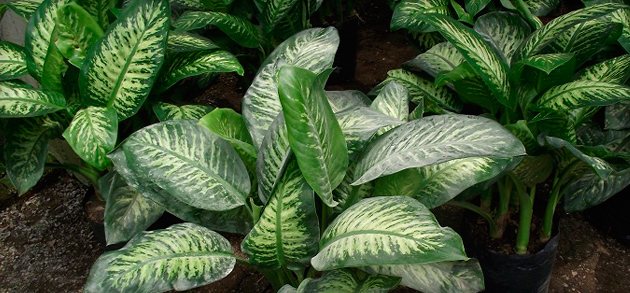

Despite the fact that the plant is deciduous and is often found not only in apartments, but also in public organizations, it is quite capricious in terms of care requirements. So, it is especially sensitive to lighting and temperature conditions. However, if you provide the plant with all the conditions for normal development, then it will delight with the intensity of its growth - a new leaf will appear almost every week.
What is the use of dieffenbachia
The lush green plant is very beautiful. It is able to decorate the interior, create coziness in an apartment or in a house. In addition to external grace and beauty, the plant also has useful qualities. The main positive quality of dieffenbachia is the ability to cleanse the air from harmful and toxic volatile components.
The structure of the plant contains useful components - phytoncides. The flower constantly releases phytoncides, they get into the air and cleanse it of pathogens and harmful compounds.
Experienced florists recommend growing Dieffenbachia to those people whose apartments or houses are located in unfavorable ecological areas. The plant is able to absorb vapors of the harmful substance formaldehyde, which causes significant damage to human health.
The huge leaves of Dieffenbachia are a natural humidifier. If you provide proper care for the flower (monitor the clean surface of the leaves), then it can effectively deal with increased dustiness in the air.
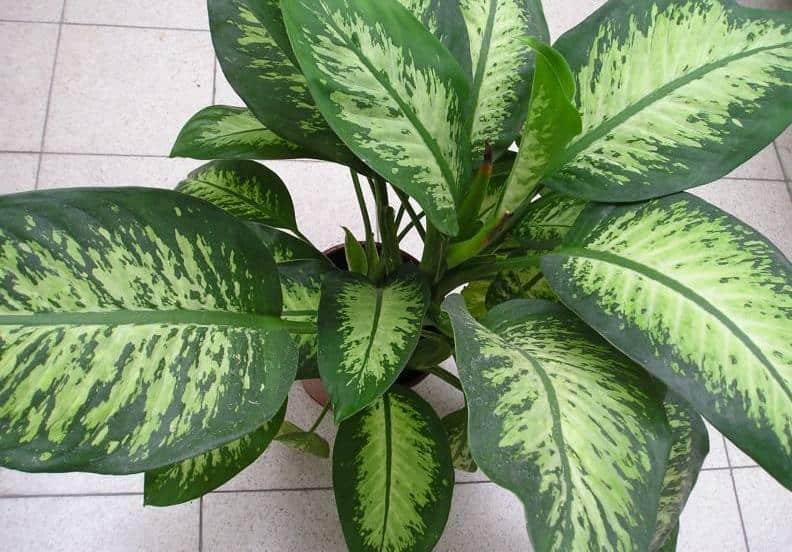

Views
Dieffenbachia spotted is the most common. It has dark leaves with light spots of various sizes and irregular shapes. This beauty reaches a height of 1 meter.
Camilla. Its leaves are green only along the edge, and white inside. A very showy plant.
Tropic Snow or Tropical Snow. A very beautiful view of Dieffenbachia. It is truly variegated, because its green leaves are all permeated with white veins and small specks.
Leopold. This variety differs from the previous ones, as it has very large leaves with a clearly carved white stripe in the middle. It grows most often on the street in hot countries.
Compact. It differs in that it is undersized and grows in bushes.
Lovely. Large, reaches 1.5 meters in height, has leaves up to 60 cm in diameter. Dark green with sparse white streaks.
Oersteda - large green leaves without white spots. The plant itself is low up to 35 cm.
Royal. The leaves are light green, have a dark edging and dark spots. Low.
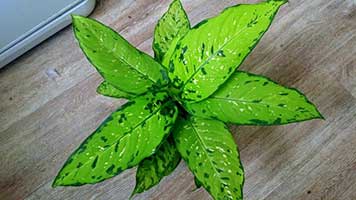

Bause. Perhaps the most unusual type of dieffenbachia. It has round, dark green leaves with brown veins and a light green spot in the middle that looks like a caterpillar.
There are many other species that are practically not found anywhere except in African countries.
Dieffenbachia harm
Despite the usefulness of dieffenbachia, some people have a question, is it poisonous or not? Indeed, the plant is poisonous.Substances with toxic properties are contained in the milky juice of dieffenbachia. If the juice gets on the skin of a person, then it instantly provokes a burn.
It is much more dangerous if poisonous juice gets on the mucous membrane of the eye or into the mouth of a person. Such negligence can lead to blindness and swelling of the tongue (in the latter case, a person loses the ability to speak for a while).
Growing dieffenbachia in a house with small children
Careless handling of the plant can cause serious health problems, so deciding whether it is possible to grow Dieffenbachia at home must be prudent. It is not recommended to purchase a flower for those who have small children or pets in the house.
If the house already has dieffenbachia and a child is born, then it is necessary to limit the contact of the baby with the plant - hang the flower from the ceiling, put it on a high stool or fence it off with a fence.


Dieffenbachia harm to pets
Poisoning and even death can cause dieffenbachia juice to pets. A feature of cats is the desire to taste the leaves of indoor flowers. Dogs often imagine the trunk of large plants with sticks for play, so they try to chew or bite them. All this can lead to poisoning of the animal or to the appearance of burns on the oral mucosa.
When the plant blooms
When growing Dieffenbachia at home, it is almost impossible to see the blooming of a flower. However, this does not mean at all that this plant does not bloom, if favorable conditions are created, then the buds are thrown out every summer. Such flowers are completely unattractive. ABOUTneither look like peculiar cobs of white-yellow color, with a grayish veil.
Neither dieffenbachia flowers, let alone ripening fruits, represent absolutely no decorative value. But during the formation of the cobs, the flower begins to wither strongly and can throw off most of the leaves. Dieffenbachia flowers are not poisonous, and there is no harm from them.
Experienced growers advise to remove the cobs, even at the stage of their formation, in order to preserve the leaves.
Energy properties of a flower
It has been known since ancient times that plants have energetic properties. They can positively or negatively affect a person. As for dieffenbachia, it will emit either favorable or negative energy, depending on the place where it grows.
- If the flower is placed in a spacious room (for example, in a large room), then it will actively purify the air, protect it from increased dustiness. In this case, the plant will also have a positive effect on a person.
- If dieffenbachia grows in a confined space and surrounded by other indoor plants, it can cause serious problems. An uncomfortable location for a plant will provoke a deterioration in the general well-being in a person. Dieffenbachia will become an energy vampire and will "pull" vital energy from the household. There are cases that the appearance of dieffenbachia in the house became the cause of the appearance of aggression and unreasonable irritability in people.
You can avoid unpleasant consequences if you create comfortable conditions for the plant to grow.
Reproduction
Dieffenbachia propagates by cuttings. For those who do not know how it is:
- It is necessary to cut off a piece of the stem of about 10 cm. It is important that it has at least one leaf or bud;
- Submerge the stem in water for 3 weeks. During this time, the root will appear;
- Now there is little to do. You need to plant a scion. It is necessary to take peat and sand in a 1: 1 ratio, medium-sized pot;
- Plant the plant in this mixture and sprinkle with earth;
You can do something like a greenhouse, so that the new Dieffenbachia takes over faster. Cut off a part from the plastic bottle and put it on top of the process. Do not forget to water sometimes.
Folk omens
The benefits of a beautiful flower have been known for a long time. There is an opinion among the people that dieffenbachia has magical powers and it depends only on human behavior that it will radiate - harm or benefit.
Dieffenbachia benefits
- The plant is able to bring good luck and wealth to the house.
- Dieffenbachia fills the house with positive energy. She is able to give good to household members, provoke the appearance of confidence and decisiveness in their character.
- If the spouses have a bad relationship, quarrels and disagreements often began to arise, the folk sages advise placing a flower in the kitchen. The positive energy of the plant will help lovers find the right solution to their disputes.
- The flower has a beneficial effect on the female energy. If ladies want to stay young, charming and sexy for a long time, then the plant should be placed in a large room and constantly monitor the purity of the leaves.
- Dieffenbachia growing in offices and offices increases the productivity of employees in the respective production.
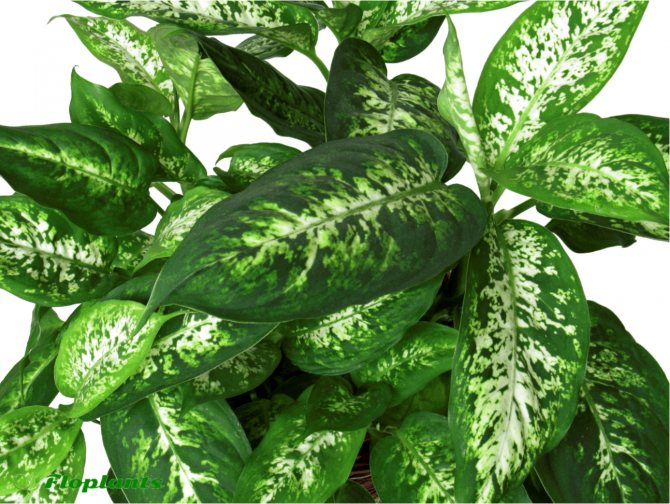

Dieffenbachia harm
- Among the people of Dieffenbachia, the name "muzegon" is assigned. If a lonely girl has a plant, then it will be problematic for her to find a faithful life partner.
- It is strictly forbidden to put a flowerpot in the bedroom, this negatively affects the sexual life of the spouses.
- Dieffenbachia is considered a purely feminine flower. If a man grows it at home, then this will negatively affect his personal life. Moreover, the plant can even provoke infertility in men.
- The flower also negatively affects the well-being of men. The more mature the plant, the more often it provokes in the representatives of the strong half of humanity the appearance of malaise, apathy, irritability, mental disorders and nerves.
A moment of positive
Summing up all of the above, a reasonable question arises: why do you need this plant at all and who else decides to grow it in the house?
Beautiful - yes, of course, but in the world there are thousands of equally beautiful and absolutely non-poisonous indoor plants, for which such a dark train of superstitions does not stretch.
Where else can you find this insidious vampire - Dieffenbachia, and who are those brave souls who risk to cherish and cherish her? (by the way, she is completely unpretentious in leaving).
As a rule, it is plant decorates
office premises, halls and offices of various administrative institutions located in the center of large cities, where there is a high background radiation and strong dustiness of the air.
One large dieffenbachia bush is capable of simultaneous
o collect all the dust, humidify the room and saturate it with the purest oxygen. Of course, people who care for these plants or work in their immediate vicinity receive safety instructions.
At the same time, ordinary citizens, who are not even inclined to believe in any mysticism, prefer to live according to the principle “out of harm's way”. If everything is not all right in the family, then why tempt fate? Well, for cheerful optimists who do not turn back at the sight of a black cat or an empty bucket, a graceful and beautiful Dieffenbachia cannot become a potential threat in any way.
In short, own intuition will tell
whether it is your flower or not, and whether you need to keep it in the house. And to the question "is it possible?" the answer is unequivocal - of course, yes!
And for those who like to know more, we suggest that you familiarize yourself with an educational video about Dieffenbachia
Dieffenbachia is an unpretentious evergreen that adorns many homes and offices. Its elongated-oval large leaves with a variegated pattern fit well into a modern interior. But when purchasing dieffenbachia to decorate your home, do not forget that this beautiful plant poses a danger to others, and especially to children.
Dieffenbachia juice has a pronounced irritant effect. Experts associate it with the content of small crystals of calcium oxalate with sharp needle-sharp edges, as well as some plant enzymes.
When dieffenbachia juice gets on the skin, dermatitis develops. The ingestion of this juice in the mouth, which occurs at the time of chewing the leaves, causes serious burns to the mucous membrane of the mouth, pharynx, tongue, larynx. It is especially dangerous if the dieffenbachia juice gets into the eyes, as it burns the cornea, which can cause permanent loss of vision.
Care features
As an indoor flower, Dieffenbachia is quite capricious and gives the owners a lot of trouble. The plant loves light, but the direct rays of the sun can discolor the leaves. In extreme heat, it is better to remove it away from the windowsill. Make sure that there are no drafts nearby and that it is warm enough.


However, you should talk in more detail about such a plant as dieffenbachia. Its benefits and harms are precisely those aspects that need to be highlighted. Of course, let's start with the positive qualities.
How does it bloom?
Not every grower can boast of blooming dieffenbachia. When breeding it for landscaping the interior, the emphasis is on variegated decorative leaves, and not on flowers. At home, flowering is rarely observed.
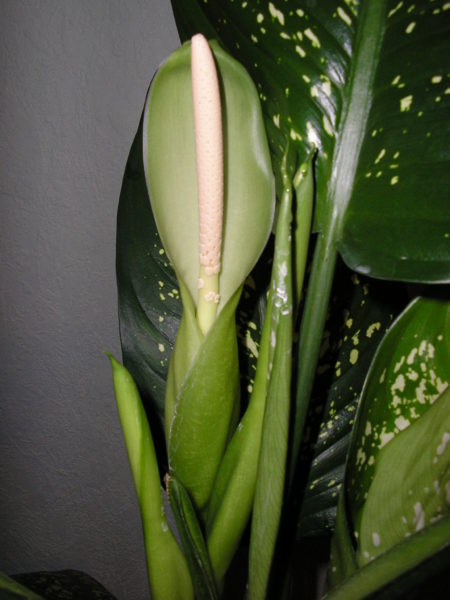

Under favorable conditions, in the middle of spring, an inflorescence of small, light yellow buds, collected on the cob, may appear on the top of the plant from the leaf axils. Above, the inflorescence is tightly wrapped in a delicate cream-colored veil.
Plant and romance
Many negative signs about the plant are broken about this fact. Even if she stands in the bedroom, in the immediate vicinity of the matrimonial bed, she will not be able to break the bond between the spouses, but, on the contrary, will give something positive to each of them.
As already mentioned, dieffenbachia also has beneficial properties. It often acts as an indicator of the state in the user's home, because it was previously believed that the plant blooms only in places with a lot of negativity. Domestic fights that occur in all parts of the home can also contribute to this.
If you often quarrel with your significant other, then it is worth eliminating the negativity that surrounds you. Dieffenbachia will not help with this, but it will be able to show you that there is negativity in the house. It will be better if a woman takes care of the plant, since dieffenbachia loves exactly the fair sex and will not tolerate being looked after by a man, no matter what his character is.
Photo gallery
The plant, under favorable conditions, grows up to 2 m in height.It should be considered in detail the useful properties and harm of dieffenbachia, a description of its varieties.
Safety precautions and assistance for dieffenbachia juice poisoning
If, nevertheless, the juice gets on the skin, eyes or oral mucosa, it is important to rinse it off as soon as possible with running water. The effects of toxins begin to be felt literally in seconds, so there is no need to hesitate.
Swallowing the leaves threatens with laryngeal edema and pain shock. These conditions are especially dangerous for children under the age of three and pets who cannot talk about their problem, which means that it is not always possible to provide them with quick help.
When the greens of dieffenbachia penetrate into the esophagus, it is necessary:
- give the victim plenty of drink in the form of warm water, milk or a weak solution of potassium permanganate;
- to ensure the receipt of a medicinal product with the functions of a sorbent for neutralization and collection of hazardous compounds in the body;
- turn to doctors for help.
So that babies and cats or dogs living in the house are not endangered, it is better to place the dieffenbachia pot out of the reach of risk categories.
Based on all that has been said, one conclusion can be drawn.Question: "Is it possible to keep Dieffenbachia, as in the photo, at home?" should be decided individually if the family has:
- people with hypersensitivity to the components of dieffenbachia juice;
- children under 3-4 years old;
- pets, especially cats, which often try to eat potted flowers.
In other cases, dieffenbachia does not pose a danger, and its owner should only follow basic precautions.
Among other things, it is worth remembering that all green plants, including dieffenbachia, actively purify the air and produce oxygen in the daytime. But at night the situation changes. Without sunlight, all home cultures replenish the atmosphere of the room with carbon dioxide, so it is better not to put large specimens not only in children's rooms and public places, but also in sleeping rooms.
What to do if poisoning has already occurred
Dieffenbachia flowers are useful - decorating any interior of the room, but this plant can also lead to serious poisoning. In order for this not to happen, it is necessary:
- Always wear gloves when replanting a flower to protect your hands from possible burns.
- Planters should be kept away from children and pets (cats).
There is a sign that this plant is able to "drive out" grooms if it grows in a girl's room. If the defenbachia has bloomed (this happens extremely rarely), then the woman will not be alone. If the plant blooms regularly, then family life will be built successfully. By will, if a kitten lives in the house where the flower grows, then they do not take root there.
From all that has been said, the following conclusions can be drawn: the dieffenbachia plant will be able to decorate the interior of your room and will not harm your home, but, on the contrary, can be beneficial, provided that it is handled correctly.
Dieffenbachia (from Lat. Dieffenbachia) is a plant of the aroid family. Due to its spectacular appearance, it is widely used for landscaping offices, hotels, holiday homes, office premises. There is an opinion that diphenbachia is poisonous and can be harmful. Before starting a flower, you need to carefully study its properties and reliably find out what benefits and harm dieffenbachia brings, whether it is poisonous or not, and whether it is possible to keep the plant at home.
Requirements for the microclimate in the apartment
Dieffenbachia is a visitor from the tropics, therefore, seduced by the beauty of the plant, do not rush to buy it. Not in all apartments, she will take root and feel comfortable.
- Dieffenbachia does not tolerate direct sunlight, she is accustomed to heat, but not to the scorching heat.
- The range of temperatures suitable for a plant varies with the season. In summer - no more than 26 degrees. In winter, no higher than 19.
- Indoor flower does not tolerate drafts. Think in advance about the place for placement so that the dieffenbachia does not blow from the window open for ventilation.
- Experts recommend maintaining the humidity level at least 55%. The plant gets the moisture it needs for life from the air. Otherwise, it will turn yellow, shed its leaves, stop growing.


What you need to remember and be able to do when growing a houseplant
Knowing the strengths and weaknesses of houseplants will help determine whether it is worth spending time and money on your chosen flowerpot or not.
Dieffenbachia will delight you with fast growth and durability - these are good qualities if you want to plant greenery on a permanent basis as soon as possible. She is not very demanding in leaving. Provide the necessary microclimate, regularly and correctly water, fertilize, transplant plants, wipe dust from wide leaves. To avoid allergic and other troubles, do not allow direct contact of plant parts with the skin. Use gloves when replanting, removing old leaves, pruning and even dusting, and wash your hands very carefully with soap and water at the end of the job.
The effect of dieffenbachia on humans
There is a sign that with good handling, a home flower can be guaranteed to improve your well-being and appearance, you will rapidly begin to lose weight and earn credibility among acquaintances and friends. Career and increased wealth are also co-factors on the path to success with Dieffenbachia.
If we plunge into the biological structure of a plant, we can find out that Dieffenbachia releases phytoncides and independently reduces the number of bad bacteria in the air, thereby improving the atmosphere in offices and offices, bedrooms and kitchens. This is due to the fact that the plant is considered to be in some way magical.
So, if you want to get the most out of dieffenbachia, we advise you to put it in your office or at your desk. It is advisable that a woman is involved in the care, and there is no negativity in your house on an ongoing basis. Then the plant will grant you its patronage.
Dieffenbachia has many fans among florists; why it is impossible to keep her at home - this question interests many. Therefore, it is useful to know both the rules for caring for indoor evergreen shrubs, and the historically ambiguous attitude towards it.
Dieffenbachia is a houseplant that has its own specifics. Among the variety of decorative flowers, it is distinguished by the presence of variegated white-green large leaves and potentially large sizes. With age, the flower loses its attractiveness due to the large number of dying stems in the lower part and requires rejuvenation.
Brown spots on leaves: causes and methods of struggle


In one wise book, the simple truth is recorded that all living things suffer from diseases. We see the truth of these words every day. Unfortunately, plants also get sick and the tropical beauty is no exception. Research shows that it is susceptible to fungal, viral and bacterial diseases. One of them manifests itself when brown spots are formed on the leaves of diffebachia, around which there is an orange border. Over time, they spread to the entire leaf, as a result of which it dies.
The main causes of the disease are caused by such factors:
Frequently asked questions about Dieffenbachia
Novice florists have many questions related to plant transplantation, care and placement in an apartment. People start a flower, and then they just begin to be interested in the conditions of detention, compatibility with other plants, and energy influence. Dieffenbachia is a difficult plant to care for and on a mental level. Not suitable for all people, not finding a common language with everyone.
Muzhegon and the flower of celibacy
Popular rumor ascribes to the plant the properties of "repelling" the stronger sex.
There is an opinion that if an unmarried lady acquires dieffenbachia, she will not be able to count on personal happiness. If there is a man in the house, he will leave or, even worse, die.
Why dieffenbachia is "crying"
In fact, it is a figurative expression. The plant, as mentioned above, is an excellent natural barometer. It reacts sensitively to the slightest changes in the weather. Before lingering showers and snowfalls, droplets of moisture appear on the leaves of dieffenbachia. You should not be afraid of this phenomenon, it only heralds an increase in the concentration of water in the air. Use this feature to know for sure if you need to grab an umbrella when leaving the house.
Where to put the plant
The space where people sleep is not the best place for dieffenbachia. At night, it actively emits carbon dioxide, so the next morning a person will feel sick.
This applies to all plants with large leaves, they are appropriate in the living room, kitchen and other places where you spend the day.
Believe the omens or not, it's a personal matter. I don’t believe in bad omens, but I don’t start a plant due to the presence of a cat and a dog. Responsible pet owners will never opt for this flower.
A little about
Ksenia Likhachevskaya Tarologist Esotericism for me is a universal key that opens many doors behind which new knowledge, opportunities and prospects are hidden.
More than 20 years ago, I first picked up Tarot cards. Since then, I have used them not only for predictions. The world of Tarot is an amazing reality, immersed in which you will find answers to questions and be able to change your life. Tarot reading services
Let's sum up


As it becomes clear from our article, Dieffenbachia is poisonous, but it will only harm if you treat it negligently. If you do not chew the plant and work with it, protecting your hands with gloves, horrors will not happen. But the benefits of the flower are greatly diminished. Excellent cleansing properties should not be overlooked. It is quite acceptable to contain it in office and industrial premises, in residential apartments and houses. It is enough just to cut off communication between your child and the plant and to differentiate the joint stay of animals with him.
For pets


Having learned about whether dieffenbachia is poisonous for people, we will analyze the situation with pets. Cats are very persistent in their desires, and if they decide to try this plant, rest assured, these cunning animals will get their way. When you are at home, you can drive away annoying foodies, but what happens when they are left alone? To avoid trouble, it is better to keep animals and dieffenbachia in different rooms. Where a dangerous beauty will live, there is no place for curious four-legged.
However, you should not despair now to find that that gorgeous flower that has been living with you for a fairly decent time is nothing more than a poisonous dieffenbachia. And at the same time, your beloved cat lives on the same rather modest living space with you. If he still hasn't touched the flower, then most likely he won't.
Dogs can taste Dieffenbachia too, so it's worth taking safety precautions. The same goes for parrots. They can nip off a piece of juicy greenery ... For parrots, such a meal with a high degree of probability can be the last.
Conditions of detention
It is possible to exclude possible intoxication of the body if all the necessary conditions for keeping the flower are fully observed. The plant is extremely unpretentious, for its normal growth it is recommended to provide light light, a humid environment and a warm atmosphere.
Dieffenbachia does not need frequent watering; you need to pay close attention to this only while the plant is young. In winter, the flower is watered only after the soil has dried to a certain depth.
Obviously, the benefits of such a plant are much greater than its negative effects. This is what causes such a large spread of the plant. Nevertheless, you need to take care of it with the utmost care, and access for small children and animals, especially cats, should be completely limited - for them the plant sap is a real poison.
Signs on the state of the flower
There are also superstitions among the people about the unusual states of the plant. If we talk about the very bioenergy, then this plant is considered the most real indicator of the accumulation of negative and destructive emotions in the house.
Signs say that if dieffenbachia has bloomed, it is worth expecting that the emotional aura in the family will worsen. This is a kind of warning against dieffenbachia.
It is believed that she begins to bloom only when there is an urgent need to urgently change something in herself, at home or at work. In short, to improve the current state of affairs.
And dieffenbachia, being a tropical plant, knows how to "cry" - to feel the approach of rains and snowfalls. In this case, the flower seeks to get rid of excess moisture in advance if the soil is heavily waterlogged.


